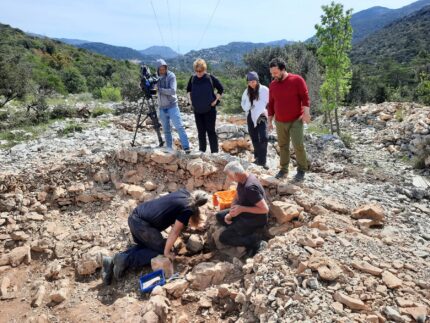 A 2,500-year-old Greek-Illyrian helmet has been discovered in the village of Zakotorac on Croatia’s Pelješac peninsula. It was unearthed by archaeologists from the Dubrovnik Museums at the Gomile cave tomb site where rich graves from the second half of the 1st millennium B.C. have been discovered since the excavation project began in 2020.
A 2,500-year-old Greek-Illyrian helmet has been discovered in the village of Zakotorac on Croatia’s Pelješac peninsula. It was unearthed by archaeologists from the Dubrovnik Museums at the Gomile cave tomb site where rich graves from the second half of the 1st millennium B.C. have been discovered since the excavation project began in 2020.
This is the second Greco-Illyrian helmet found in the Gomile excavations. The previous example was found in a grave along with fragments of iron weapons and thus likely belonged to a member of the warrior elite who was buried there. The recently-discovered helmet was found in a dry stone-walled addition to a grave, so archaeologists believe it may have been a votive deposit.
 The helmets are of different types and dates. The one discovered in 2020 is an open-faced helmet with a rectangular cut-out for the face edged with a decorative border, a variant in active use in Greece and Illyria in the 4th century B.C. The most recent helmet is older, dating to the 6th century B.C. Few examples of the 4th century B.C. type have survived, with only about 40 known in Europe, and the 6th century B.C. helmets are even more rare. Finding two different Greek-Illyrian helmets at one site is unprecedented.
The helmets are of different types and dates. The one discovered in 2020 is an open-faced helmet with a rectangular cut-out for the face edged with a decorative border, a variant in active use in Greece and Illyria in the 4th century B.C. The most recent helmet is older, dating to the 6th century B.C. Few examples of the 4th century B.C. type have survived, with only about 40 known in Europe, and the 6th century B.C. helmets are even more rare. Finding two different Greek-Illyrian helmets at one site is unprecedented.
What is very interesting is that two different types appear here in the same place, which actually speaks of a continuity of power of the respective community. These helmets have always been a symbol of some kind of status and power, said Dr. sc. Hrvoje Potrebica , from the Department of Archeology of the Faculty of Philosophy in Zagreb.
The highly valuable and rare helmets keep company with other exceptional grave goods, including 15 bronze and silver fibulae, 12 needles, spiral bronze jewelry, bronze tweezers, hundreds of glass and amber beads, a bronze diadem and more than three dozen vessels of Greek origin, most of them made in Attic and Italic workshops. These were the most highly prized pieces of pottery of the time. If acquired via trade, the cost would have been prohibitive. It’s also possible they were acquired by piracy, a pursuit the Illyrian warriors on the Adriatic coast were famous for.
It’s an Illyrian helmet. Why people keep saying Greek Illyrian?! Why changing the history?